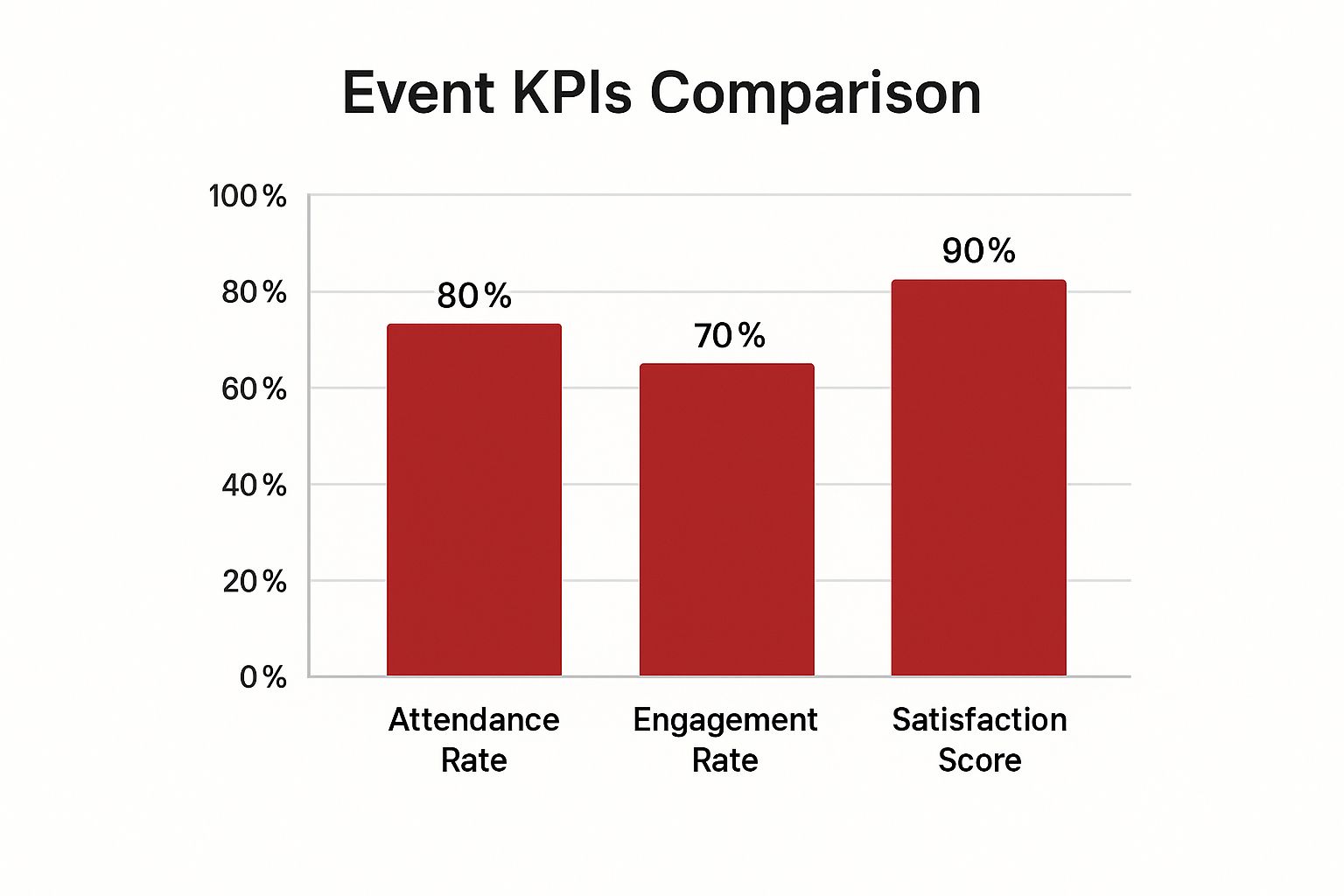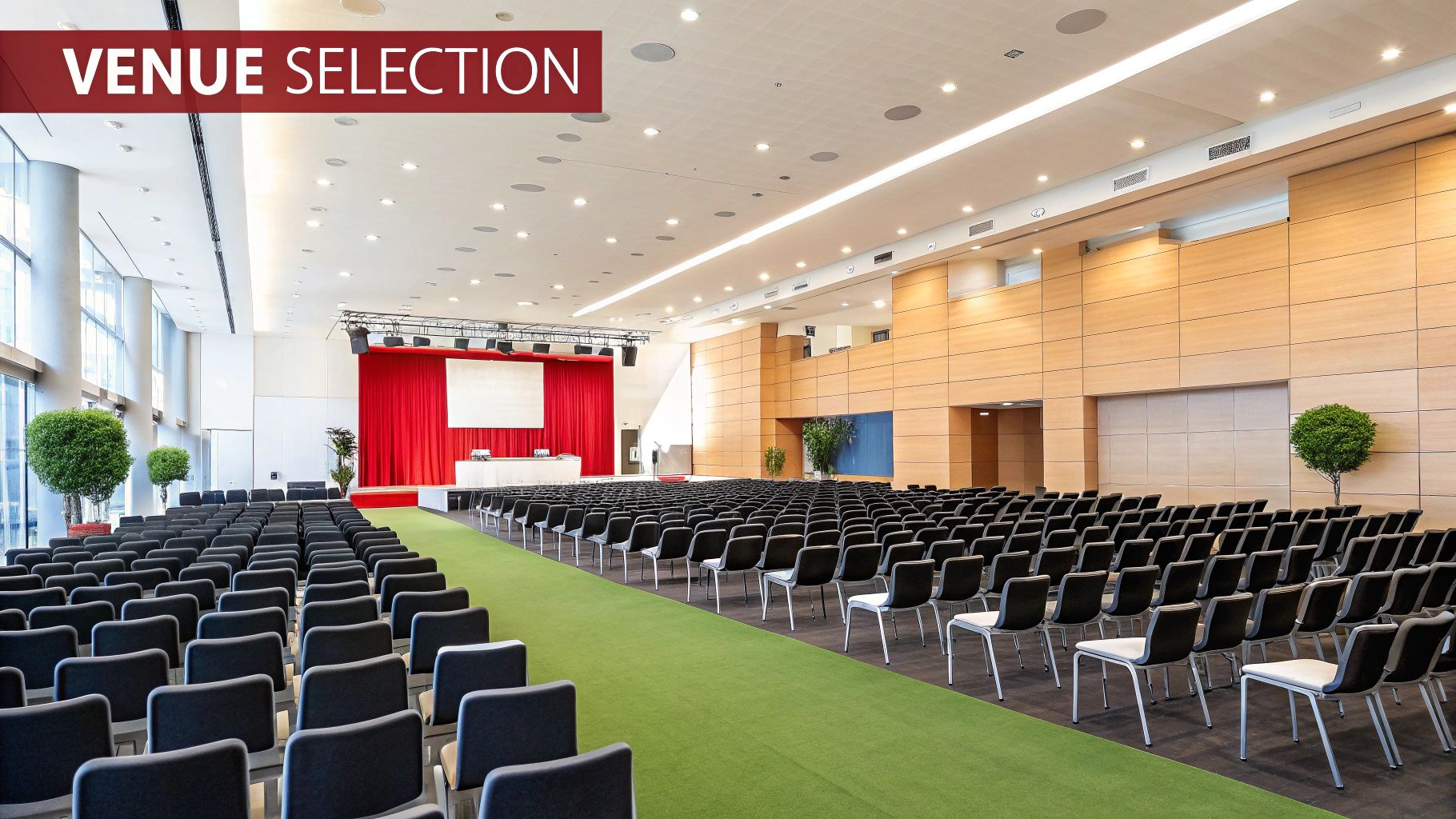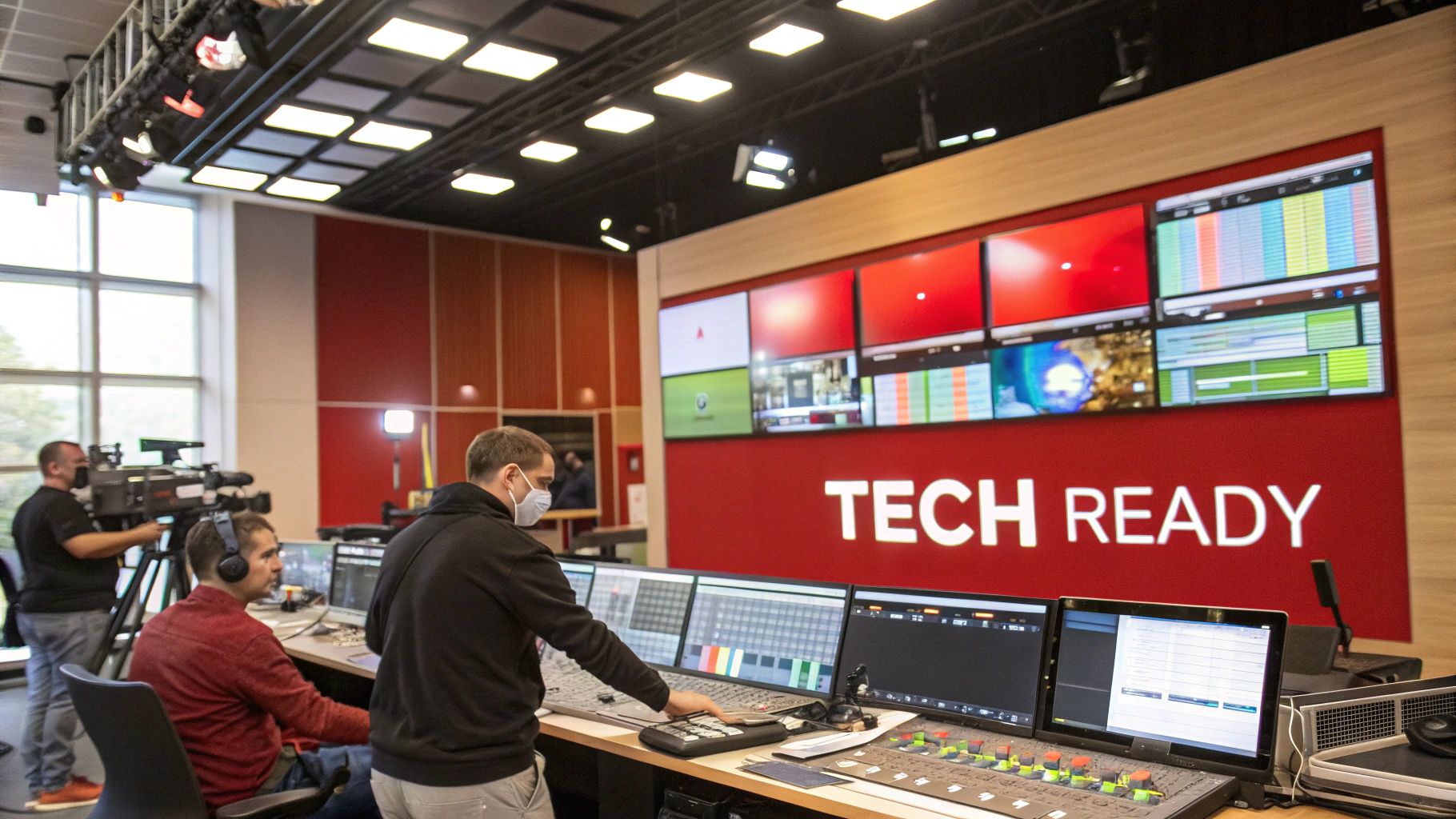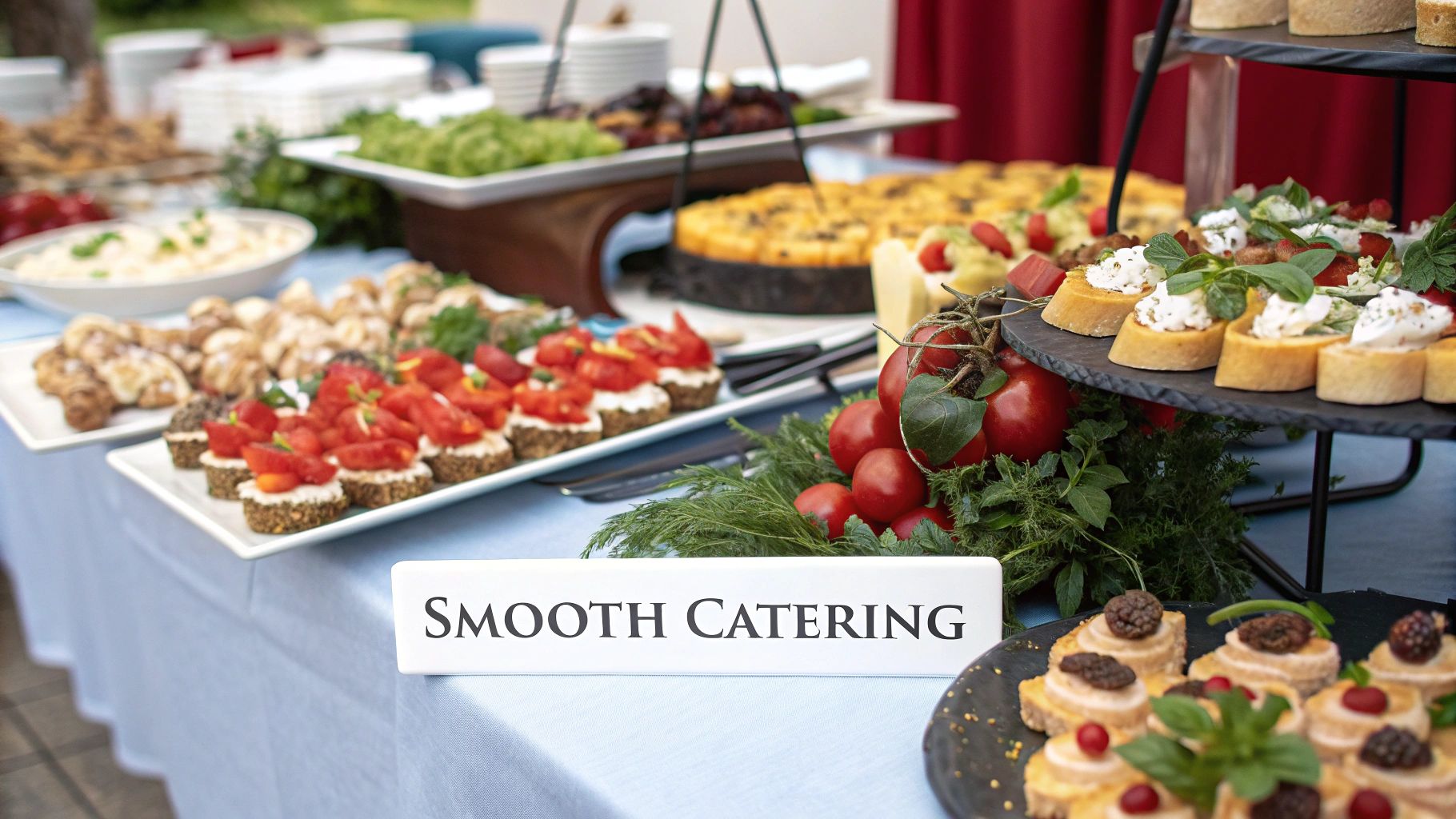Planning a corporate event requires more than just securing a venue and sending invites. It's about creating an immersive experience that resonates with attendees, achieves strategic business goals, and leaves a lasting impression. From product launches that captivate to conferences that build communities, the key to success lies in meticulous planning and flawless execution. This comprehensive corporate event checklist is designed to guide you through every critical stage, from initial strategy to post-event analysis.
We will explore ten essential steps, providing actionable insights, expert tips, and fresh perspectives to ensure your next event isn't just successful, but truly memorable. Throughout this guide, we'll highlight how to strategically integrate high-value promotional items, like custom electronics, to elevate the attendee experience and extend your brand's reach long after the closing remarks. Consider this your blueprint for moving beyond basic event coordination to masterminding an impactful brand moment. You'll gain practical tools for defining goals, managing budgets, coordinating vendors, and measuring the true return on your investment, ensuring no detail is overlooked.
1. Define Event Goals and Key Performance Indicators (KPIs)
Before booking a venue or drafting an invitation, the most critical first step in any corporate event checklist is defining what success looks like. This foundational stage involves establishing clear, measurable objectives that will guide every subsequent decision. Whether your primary goal is generating qualified leads, boosting employee morale, launching a new product, or increasing brand awareness, having specific targets is non-negotiable.
For example, a major tech conference like Microsoft Build sets goals beyond mere attendance; they target developer engagement, session feedback scores, and new product adoption rates. This level of specificity transforms the event from a simple gathering into a strategic business initiative with a clear return on investment (ROI).
Actionable Implementation Steps
- Host a Stakeholder Workshop: Bring together key decision-makers from sales, marketing, product, and leadership to align on primary and secondary event goals.
- Establish Baselines: Document your current metrics before the event. If a goal is lead generation, what is your current monthly average? This provides a benchmark for measuring success.
- Assign KPI Ownership: Make specific teams or individuals responsible for tracking each KPI, ensuring accountability throughout the event lifecycle.
The following chart illustrates how different KPIs can be tracked to measure the overall success of an event.

This visual comparison helps stakeholders quickly assess performance against targets, identifying both strengths and areas needing improvement for future events.
2. Budget Planning and Financial Management
With your goals defined, the next crucial element in any corporate event checklist is establishing a comprehensive budget. This isn't just about listing expenses; it's about strategic financial management that allocates resources effectively to achieve your KPIs. Proper budget planning accounts for all potential costs, from major vendor contracts to minor administrative fees, ensuring your event delivers maximum impact without exceeding financial constraints.
For instance, a massive event like CES in Las Vegas operates with a multi-million dollar budget where every line item is meticulously planned and tracked. Their financial management covers everything from intricate booth constructions and high-tech audiovisual production to staffing and global marketing campaigns. This rigorous financial control is what enables them to execute a world-class experience while ensuring a positive return on investment.
Actionable Implementation Steps
- Use Past Data as a Baseline: Analyze budgets from previous, similar events to create a realistic starting point. Identify what was over or under-spent to refine your estimates.
- Secure Multiple Vendor Quotes: For significant expenses like venue, catering, and AV, obtain at least three competitive bids. This not only helps control costs but also reveals different service options.
- Implement Real-Time Tracking: Utilize event management software or a detailed spreadsheet to monitor expenses as they are incurred. This prevents surprises and allows for quick adjustments. For a detailed guide, you can learn more about how to create a comprehensive event budget planning template on electronicfinishing.solutions.
- Set Approval Thresholds: Establish a clear process for expense approvals. For example, any expenditure over a certain amount, like $1,000, might require sign-off from a senior manager, ensuring accountability and preventing budget creep.
3. Venue Selection and Space Planning
The right venue is more than just a backdrop; it's a critical component that shapes the entire attendee experience and logistical framework of your event. This step in your corporate event checklist involves strategically sourcing a location that aligns with your event goals, brand image, and audience needs. Key considerations include capacity, technical capabilities, accessibility, transportation links, and overall cost-effectiveness, all of which directly impact event flow and success.

For instance, the consistent choice of the CHI Health Center for the Berkshire Hathaway Annual Meeting reinforces brand stability and handles massive crowds with ease. In contrast, TED Talks often selects more intimate, architecturally unique venues to foster a sense of focus and exclusivity, directly supporting its goal of spreading powerful ideas. This shows how venue choice is a strategic decision, not just a logistical one.
Actionable Implementation Steps
- Conduct Site Visits: Always visit your top venue choices in person, preferably while a similar event is taking place. This provides a real-world sense of the space's acoustics, flow, and operational capabilities.
- Negotiate Flexible Contracts: Work with the venue to include flexible terms and a clear force majeure clause. This protects your investment against unforeseen circumstances that could lead to cancellation or postponement.
- Create Detailed Floor Plans: Use software or work with the venue manager to map out every area, from registration desks and breakout rooms to networking lounges and sponsor booths. This ensures optimal traffic flow and maximizes space utilization.
- Assess Technical Infrastructure: Confirm the venue’s Wi-Fi can handle your expected number of attendees and that its A/V equipment meets your presentation and streaming needs. Inquire about on-site technical support availability and costs.
4. Technology and Audio-Visual Requirements
In today’s digitally driven landscape, technology is the central nervous system of any successful corporate event. A comprehensive corporate event checklist must prioritize all technical aspects, from crystal-clear sound systems and dynamic lighting to high-definition projection and robust streaming capabilities. This involves meticulously planning for both front-of-house presentation technology and back-of-house operational systems like registration platforms and event apps.

Events like Adobe MAX demonstrate this masterfully, using advanced streaming technology to engage a global virtual audience simultaneously with their in-person attendees. Similarly, SXSW’s acclaimed mobile app serves as an indispensable tool for attendees to manage schedules, network, and navigate the sprawling event. Neglecting this area can lead to disengaged audiences and technical failures that undermine the entire experience.
Actionable Implementation Steps
- Conduct a Full Technical Rehearsal: Schedule a complete run-through with all speakers, presenters, and AV staff. Use the actual venue’s power and internet to test presentations, microphones, and lighting cues to identify potential issues beforehand.
- Develop a Contingency Plan: What happens if the primary projector fails or the internet goes down? Have backup equipment (laptops, projectors, microphones) and a clear plan of action, including offline registration forms, ready to deploy.
- Assign Dedicated Tech Support: Designate specific AV technicians or IT staff to manage key areas like the main stage, breakout rooms, and the registration desk. Ensure attendees and speakers know who to contact for immediate assistance.
The following video provides a deeper look into the essentials of planning event AV and technology to ensure a seamless production.
By thoroughly vetting and planning your technology stack, you create a professional, reliable, and engaging environment that reflects positively on your brand and maximizes attendee satisfaction.
5. Speaker and Entertainment Coordination
The speakers and entertainers you select can make or break an event, transforming a standard gathering into a memorable experience. This step in the corporate event checklist involves the end-to-end management of all presenters, from keynote speakers and expert panelists to performers. It requires aligning their expertise and style with your event goals and audience expectations to ensure they deliver compelling, resonant content.
For instance, Salesforce's Dreamforce conference is renowned for featuring a diverse lineup of industry titans, celebrity innovators, and political figures, which draws massive attendance and reinforces its brand as a forward-thinking leader. Similarly, TED's rigorous speaker selection and coaching process ensures every talk is impactful, a model of quality content delivery.
Actionable Implementation Steps
- Book Talent Early: High-demand speakers and entertainers are often booked 6-12 months in advance. Start your outreach and negotiation process as soon as your event date is confirmed.
- Create Detailed Speaker Briefs: Equip your speakers for success by providing a comprehensive brief. This should include audience demographics, key event themes, logistical details, and specific content expectations. For events featuring workshops, exploring interactive workshop activities can help speakers design more engaging sessions.
- Schedule Pre-Event Alignment Calls: A call a few weeks before the event is crucial for reviewing presentations, confirming AV requirements, and addressing any last-minute questions, ensuring a smooth on-site experience for everyone. A thoughtful speaker gift, such as high-quality branded tech, can also be a great way to show appreciation. For more inspiration, explore these 10 event giveaway ideas to wow your audience.
6. Select a Registration and Attendee Management System
A robust registration and attendee management system is the operational backbone of any corporate event. This technology handles the entire attendee journey, from the first click on a registration link to the final post-event survey. Selecting the right platform is a crucial step in any corporate event checklist, as it automates ticket sales, streamlines communication, and provides critical data insights.
For instance, large-scale corporate conferences like those hosted by Cvent for enterprise clients manage complex logistics such as tiered pricing for different attendee types (early bird, VIP, standard) and session-specific sign-ups. This ensures a seamless and professional experience, preventing data entry errors and long check-in lines that can tarnish an otherwise well-planned event.
Actionable Implementation Steps
- Define Your Requirements: Map out essential features before comparing platforms. Do you need CRM integration, badge printing capabilities, a mobile app, or detailed analytics dashboards?
- Establish Communication Workflows: Set up automated confirmation, reminder, and "know before you go" emails within the system. This keeps attendees informed and reduces manual follow-up.
- Test the User Experience: Before going live, conduct a thorough test of the entire registration process from an attendee's perspective to identify and fix any points of friction or confusion.
- Plan for On-Site Check-In: Choose a system that supports modern, mobile-friendly check-in processes. Using QR codes on branded lanyards or a dedicated app can significantly speed up entry and impress attendees from the start.
7. Catering and Food Service Management
Thoughtful catering is far more than just feeding attendees; it’s a powerful tool for shaping the event experience and reinforcing your brand identity. Strategic food and beverage management involves coordinating everything from menu selection and service style to dietary accommodations and timing. This element of your corporate event checklist can transform a simple meal break into a memorable networking opportunity that enhances the overall atmosphere.

For instance, Google I/O often features innovative and diverse food stations that mirror the company's creative and inclusive culture. Similarly, a conference focused on sustainability might offer locally sourced, plant-based options to align with its core values. These choices demonstrate attention to detail and a commitment to the attendee experience that goes beyond the main stage.
Actionable Implementation Steps
- Integrate Dietary Questions into Registration: Add a mandatory field in your event registration form to collect information on allergies, restrictions (gluten-free, vegan, kosher), and preferences. Share this data with your caterer well in advance.
- Align Service Style with Event Flow: Choose a service style that supports your schedule. A buffet is efficient for a quick lunch, while passed hors d'oeuvres encourage mingling during a reception. Seated dinners are better for formal presentations or awards.
- Incorporate Local Flavors: Partner with caterers who can feature local cuisine. This offers attendees a unique taste of the host city, creating a more immersive and memorable event experience.
- Develop a Contingency Plan: Work with your caterer to create a plan for unexpected attendance changes. This includes having a buffer for both over- and under-attendance to manage food costs and prevent shortages.
8. Marketing and Promotional Strategy
Once your event's core strategy is set, the next item on your corporate event checklist is to build a comprehensive promotional plan. A powerful marketing strategy is essential for creating awareness, driving registrations, and generating buzz. This involves a multi-channel approach that engages your target audience across various touchpoints, from initial announcement to post-event follow-up, ensuring maximum attendance and impact.
For instance, Salesforce’s Dreamforce conference executes a masterful integrated campaign that leverages every company channel, from social media and email marketing to content hubs and partner networks. This creates an immersive promotional experience that builds excitement and urgency, transforming the event into a can't-miss industry moment. Your strategy should similarly aim to surround your audience with value-driven messaging.
Actionable Implementation Steps
- Launch Early and Create a Timeline: Begin your marketing efforts at least 3-6 months prior to the event date. Develop a detailed content calendar that outlines key messages, channel distribution, and promotional milestones.
- Leverage Partner Networks: Empower your speakers, sponsors, and exhibitors to become brand ambassadors. Provide them with a pre-made promotional kit containing graphics, sample social media posts, and unique discount codes to share with their networks.
- Create Value-Driven Content: Go beyond simple event announcements. Develop blog posts, webinars, or whitepapers related to your event's theme that provide genuine value to your target audience. This positions your event as a source of industry expertise.
Developing a robust marketing plan is crucial for turning a well-planned event into a well-attended one. To help structure your promotional efforts, you can explore a detailed event marketing strategy template for more insights.
9. Risk Management and Contingency Planning
Even the most meticulously planned corporate event can be derailed by unforeseen circumstances. This step involves systematically identifying, assessing, and mitigating potential risks that could jeopardize event success, safety, or your company's reputation. A comprehensive risk management strategy moves beyond simple what-ifs to create concrete, actionable backup plans for every critical event component.
For example, when major conferences like SXSW face potential disruptions such as severe weather or health crises, their contingency plans are activated. These plans might include shifting to a fully virtual format, rescheduling keynotes, or implementing strict on-site health protocols. This proactive approach ensures the event can adapt and continue, protecting both attendees and the brand's integrity.
Actionable Implementation Steps
- Conduct a Risk Assessment Workshop: Gather your team to brainstorm all potential risks, from technical failures and speaker cancellations to weather disruptions and cybersecurity threats. Categorize them by likelihood and potential impact.
- Develop Scenario-Specific Plans: Create clear, step-by-step contingency plans for your highest-priority risks. What is the immediate response if the main sound system fails? Who is the backup keynote speaker?
- Establish a Communication Tree: Prepare pre-approved communication templates for various emergency scenarios to ensure clear, calm, and timely information is shared with attendees, staff, and stakeholders. A cornerstone of robust safety planning involves understanding what a fire risk assessment entails, ensuring you're fully prepared for potential hazards at your event venue.
- Review Insurance and Legal Obligations: Consult with legal and insurance professionals to ensure your event has adequate coverage for liability, cancellation, and other potential issues. This is a non-negotiable part of any corporate event checklist.
10. Post-Event Follow-up and ROI Measurement
The event isn't over when the last guest leaves; the post-event phase is where you secure its long-term value. This final, crucial item on any corporate event checklist involves a systematic approach to nurturing relationships, analyzing data, and calculating the true return on investment (ROI). Effective follow-up transforms one-time attendees into lasting brand advocates and business partners, ensuring your investment continues to pay dividends long after the lights go down.
For instance, after its annual INBOUND conference, HubSpot executes a sophisticated follow-up strategy. Attendees receive personalized emails with links to session recordings, relevant blog posts, and tailored content based on their tracked interests. This not only reinforces the event's value but also seamlessly guides prospects further down the sales funnel, demonstrating a mastery of post-event engagement.
Actionable Implementation Steps
- Deploy Surveys Immediately: Send out feedback surveys within 24-48 hours of the event's conclusion to capture fresh, accurate impressions. Incentivize completion with a small gift or entry into a prize draw.
- Segment Your Follow-up: Create different communication tracks based on attendee behavior. A prospect who visited a product demo booth should receive a different message than a C-level executive who attended a networking dinner.
- Schedule a Post-Mortem Meeting: Gather your internal team and key vendors for a debriefing session. Discuss what went well, what challenges arose, and what can be improved for the next event. For comprehensive post-event analysis and to maximize future returns, explore various strategies to improve marketing ROI and apply them to your event framework.
- Repurpose Event Content: Turn keynote speeches, panel discussions, and workshop highlights into blog posts, social media clips, and on-demand video content. This extends the event's reach and provides ongoing value. To understand this better, learn more about measuring event marketing ROI.
Corporate Event Checklist Comparison
| Item | Implementation Complexity 🔄 | Resource Requirements ⚡ | Expected Outcomes 📊 | Ideal Use Cases 💡 | Key Advantages ⭐ |
|---|---|---|---|---|---|
| Define Event Goals and KPIs | Medium - requires strategic planning | Low - mainly stakeholder input | Clear success metrics, alignment, ROI measurement | Setting event direction and success criteria | Provides clarity, improves stakeholder buy-in |
| Budget Planning and Financial Management | High - detailed, ongoing tracking | High - financial data and software tools | Cost control, ROI clarity, financial risk mitigation | Large-scale events with complex finances | Prevents overruns, supports negotiations |
| Venue Selection and Space Planning | Medium - requires venue research and visits | Medium - venue visits and contract review | Optimal attendee experience, attendance impact | Events needing specific capacities and logistics | Enhances attendee satisfaction and networking |
| Technology and Audio-Visual Requirements | High - technical setup and rehearsals | High - specialized equipment and staff | Engaging presentation, broad reach, data collection | Hybrid/virtual and tech-heavy events | Professional delivery, expands event reach |
| Speaker and Entertainment Coordination | High - contracts, logistics, and rehearsals | Medium - HR and coordination efforts | High engagement, credibility, media attention | Keynote and entertainment-driven events | Boosts attendance, enhances content quality |
| Registration and Attendee Management System | Medium - system setup and training | Medium - software platforms and staff | Streamlined registration, valuable attendee data | Events with complex attendee flows | Improves experience, reduces admin workload |
| Catering and Food Service Management | Medium - menu planning and vendor management | Medium - food service and coordination | Enhanced attendee satisfaction and networking | Events with meal services | Elevates experience, reinforces brand image |
| Marketing and Promotional Strategy | High - multi-channel campaign execution | High - marketing team and budget | Increased awareness, attendance, measurable ROI | Events needing strong audience engagement | Drives attendance, builds brand momentum |
| Risk Management and Contingency Planning | High - detailed risk assessment and plans | Medium - planning team involvement | Mitigated risks, quick responses, reputation protection | Events with high exposure or potential risks | Protects investment, provides peace of mind |
| Post-Event Follow-up and ROI Measurement | Medium - data analysis and communications | Medium - analytics tools and staff | Maximized ROI, ongoing engagement, event improvement | All events seeking measurable impact | Justifies budgets, sustains relationships |
Transforming Your Checklist into a Resounding Success
Successfully navigating the extensive corporate event checklist we have detailed is about more than just ticking boxes; it is about orchestrating a memorable and impactful brand experience. This comprehensive guide moves you from the foundational stages of defining goals and managing budgets to the critical execution phases of technology integration, marketing, and on-site logistics. Each step represents a vital opportunity to reinforce your message and connect with your audience on a deeper level.
The difference between a good event and an unforgettable one often lies in the details. By meticulously planning everything from your attendee registration system to your risk management contingencies, you build a solid framework that allows for creative, engaging elements to shine. Remember, the ultimate goal is not just to host an event but to achieve tangible business outcomes, whether that's lead generation, employee morale, or heightened brand awareness.
Key Takeaways for Flawless Execution
As you begin to implement this checklist, keep these core principles at the forefront of your strategy:
- Strategy First, Logistics Second: Before a single vendor is contacted, your event's purpose, KPIs, and target audience must be crystal clear. This strategic foundation will inform every subsequent decision, ensuring a cohesive and purposeful experience.
- Experience is Everything: Focus on the attendee journey from the moment they receive the invitation to the final post-event survey. Every touchpoint, from the catering to the audio-visual quality, contributes to their overall perception of your brand.
- Technology as an Enhancer: Leverage technology not just for operational efficiency but as a tool for engagement. Seamless registration, interactive apps, and high-quality presentations are no longer luxuries; they are expectations. Integrating premium, custom-branded electronics as gifts or prizes can elevate this experience significantly, creating a lasting and positive brand association.
Actionable Next Steps
With this framework in hand, your next step is to translate this comprehensive corporate event checklist into a living document for your team. Start by assigning ownership for each of the ten major pillars discussed. Create a master timeline with clear deadlines and dependencies, and schedule regular check-in meetings to ensure alignment and address challenges proactively.
Embrace the idea that this checklist is a dynamic tool, not a static document. It should be adapted to the specific scale, budget, and objectives of your unique event. By approaching the planning process with diligence, creativity, and a relentless focus on delivering value, you are setting the stage for an event that not only runs smoothly but also resonates with attendees long after they have left. The power of a well-executed corporate event to build relationships and drive business forward cannot be overstated. With this guide, you are well-equipped to make your next event a resounding success.
Ready to elevate your attendee experience with unforgettable, premium tech gifts? Electronic Finishing Solutions specializes in custom-branding high-end electronics from brands like Apple, Bose, and Sony, turning them into powerful promotional tools that leave a lasting impression. Visit Electronic Finishing Solutions to explore how our products can seamlessly integrate into your corporate event checklist and amplify your brand's impact.



